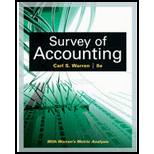
Assume that a lawyer bills her clients $15000 on June 30, for services rendered during June. The lawyer collects $8500 of the billings during July and the remainder in August. Under the accrual basis of accounting, when would the lawyer record the revenue for the fees?
A. June, $15,000; July, $0; and August, $0
B. June, $0; July, $6,500; and August, $8,500
C. June, $8,500; July, $6,500; and August, $0
D. June, $0; July, $8,500; and August, $6,500
Concept Introduction:
Accrual Basis accounting:
Under the accrual basis, the revenue and expenses are recorded accreting to their accrual for the given period and cash receipts and payments are not considered to decide their accrual. The net income is calculated using the accrued revenue and accrued expenses belonging to the particular period.
To Indicate:
The time of recording the revenue using the accrual method
Answer to Problem 1SEQ
A. June $15,000, July $0, August $0
Explanation of Solution
Under the accrual basis, the revenue and expenses are recorded accreting to their accrual for the given period and cash receipts and payments are not considered to decide their accrual. The net income is calculated using the accrued revenue and accrued expenses belonging to the particular period.
In the given case the lawyer has performed the services of $15,000 in the month of June; hence the revenue for the month of June shall be $15,000. And there shall be no revenue recognized for the months August and September.
Want to see more full solutions like this?
Chapter 3 Solutions
Survey of Accounting - With CengageNOW 1Term
Additional Business Textbook Solutions
Economics of Money, Banking and Financial Markets, The, Business School Edition (5th Edition) (What's New in Economics)
Gitman: Principl Manageri Finance_15 (15th Edition) (What's New in Finance)
Intermediate Accounting (2nd Edition)
Horngren's Accounting (12th Edition)
Essentials of MIS (13th Edition)
- Please provide the accurate answer to this financial accounting problem using appropriate methods.arrow_forwardI am searching for the accurate solution to this general accounting problem with the right approach.arrow_forwardCan you help me solve this general accounting question using the correct accounting procedures?arrow_forward
- Can you help me solve this general accounting question using the correct accounting procedures?arrow_forwardI need help solving this general accounting question with the proper methodology.arrow_forwardI need the correct answer to this general accounting problem using the standard accounting approach.arrow_forward
 Individual Income TaxesAccountingISBN:9780357109731Author:HoffmanPublisher:CENGAGE LEARNING - CONSIGNMENT
Individual Income TaxesAccountingISBN:9780357109731Author:HoffmanPublisher:CENGAGE LEARNING - CONSIGNMENT College Accounting (Book Only): A Career ApproachAccountingISBN:9781337280570Author:Scott, Cathy J.Publisher:South-Western College Pub
College Accounting (Book Only): A Career ApproachAccountingISBN:9781337280570Author:Scott, Cathy J.Publisher:South-Western College Pub College Accounting (Book Only): A Career ApproachAccountingISBN:9781305084087Author:Cathy J. ScottPublisher:Cengage Learning
College Accounting (Book Only): A Career ApproachAccountingISBN:9781305084087Author:Cathy J. ScottPublisher:Cengage Learning Intermediate Accounting: Reporting And AnalysisAccountingISBN:9781337788281Author:James M. Wahlen, Jefferson P. Jones, Donald PagachPublisher:Cengage Learning
Intermediate Accounting: Reporting And AnalysisAccountingISBN:9781337788281Author:James M. Wahlen, Jefferson P. Jones, Donald PagachPublisher:Cengage Learning





